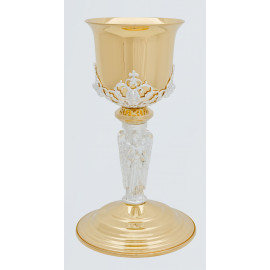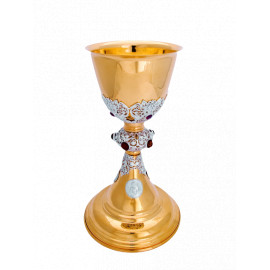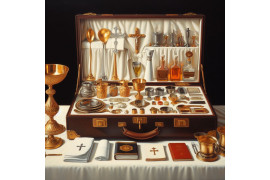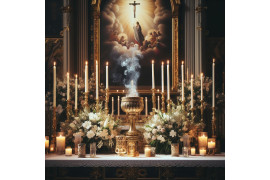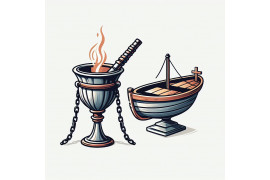In the heart of every church, a sacred vessel stands tall - the chalice. This humble cup holds a rich history that spans centuries and connects us to ancient civilizations. From its early origins crafted from clay, stone, or wood, the chalice has evolved into a symbol of reverence and spiritual significance.
Throughout the Middle Ages, chalices became more ornate and elaborate, adorned with intricate designs and precious metals. They were used to hold the consecrated wine during Mass, representing the blood of Christ. The flaming chalice, an iconic symbol in Unitarian Universalist churches today, traces its roots back to medieval times.
Join us on a journey as we delve into the captivating story behind this cherished object of worship. Discover why the chalice holds such importance in religious ceremonies, and how it continues to inspire faith and devotion today.
Importance of the chalice in religious ceremonies
The chalice holds immense significance in religious rituals, symbolizing the presence of divinity and spiritual nourishment. Its use during communion or other sacraments creates a sense of reverence and connection to the divine.
Symbolic Significance
The chalice is a sacred vessel that carries deep symbolic meaning within religious traditions. It represents the grave importance of faith and spirituality. Just as a cup holds liquid, the chalice holds the essence of divine grace and blessings. It serves as a tangible reminder of the spiritual nourishment provided by God.
Connection to Communion
One of the primary uses of the chalice is during communion, also known as the Eucharist or Lord's Supper. This significant sacrament involves partaking in bread and wine, which symbolize Christ's body and blood. The chalice contains the wine that represents Jesus' bloodshed for humanity's salvation. By drinking from it, believers participate in this sacred act and establish a profound connection with their faith.
Reverence and Respect
The presence of the chalice evokes feelings of awe, reverence, and respect among worshipers. Its ornate design often reflects its importance, adorned with intricate engravings or precious metals such as gold or silver. This visual representation enhances its significance within religious ceremonies, emphasizing its role as a vessel for divine blessings.
Spiritual Nourishment
The chalice serves as a conduit for receiving spiritual nourishment during religious services. When individuals drink from it during communion, they believe they are partaking in Christ's eternal love and grace. It symbolizes their union with God and reinforces their commitment to living according to His teachings.
Rituals Beyond Communion
While communion is perhaps one of the most well-known rituals involving the chalice, it is not limited to this sacrament alone. The chalice may also be used during other religious ceremonies, such as baptisms, weddings, or ordinations. In these instances, it represents the sanctity and solemnity of the occasion, underscoring the importance of the commitment being made.
Personal Connection
The chalice holds personal significance for individuals within religious communities. It can be a cherished heirloom passed down through generations or a vessel specially crafted for a specific purpose. This personal connection deepens one's reverence for the chalice and enhances their spiritual experience during religious ceremonies.
Symbolism of the chalice in Christianity
The chalice holds great significance in Christian religious ceremonies, representing profound symbolism that is deeply rooted in the faith. Let's explore the various meanings attributed to the chalice within Christianity.
Blood of Christ Shed for Salvation
One of the primary symbolic representations of the chalice is its association with the blood of Christ shed for salvation. In Christianity, it is believed that Jesus willingly sacrificed himself on the cross, shedding his blood to redeem humanity from sin. The chalice serves as a vessel that holds this sacred blood, reminding believers of Jesus' ultimate act of love and sacrifice.
Representation of Jesus' Sacrifice and Presence in the Eucharist
The chalice also symbolizes Jesus' sacrifice during the Last Supper, where he shared bread and wine with his disciples, instructing them to do so in remembrance of him. This event forms the basis for the sacrament of Holy Communion or Eucharist in Christian worship. The chalice becomes a focal point during this ritual, representing both Jesus' sacrifice on the cross and his continued presence among believers through communion.
Cup Symbolizing Abundance and Grace
The shape of the chalice itself carries symbolism related to abundance and grace. Resembling a cup or goblet, it signifies overflowing blessings bestowed upon believers by God. Just as a cup can be filled to its brim with liquid, Christians believe that God's grace overflows abundantly into their lives through their faith and relationship with Jesus Christ.
Wine Signifying Spiritual Transformation
Within the chalice lies wine, which holds its own symbolic meaning within Christian tradition. Wine represents spiritual transformation and renewal. As it is consumed during communion, it serves as a reminder that through partaking in Jesus' body and blood symbolically represented by bread and wine), believers are spiritually nourished and transformed into closer likeness with Christ.
The role of the chalice in the Eucharist
The chalice plays a significant role in the Eucharist, the central sacrament of Christianity. During this sacred ritual, wine is consecrated within the chalice to represent Christ's blood, symbolizing his sacrifice for humanity. Let's delve into why the chalice holds such importance in the Eucharist.
Wine as Representation
In the Eucharist, believers commemorate Jesus' Last Supper with his disciples. Just as Jesus shared bread and wine with his followers, Christians partake in communion from the chalice to symbolize their participation in Christ's sacrifice. The wine within the chalice represents Christ's bloodshed for their redemption and forgiveness of sins.
Spiritual Nourishment
By receiving communion from the chalice, believers receive spiritual nourishment. It is believed that through this act, they are spiritually united with Christ and receive grace from God. The act of drinking from the chalice signifies a personal connection and intimate relationship between individuals and their faith.
Fostering Unity
The sharing of wine from a common cup fosters unity among worshipers during the Eucharist. It emphasizes that all believers are part of one body—the body of Christ—and are united by their shared faith. This communal act reinforces a sense of belonging and solidarity within the Christian community.
Participation in Sacrifice
When believers drink from the chalice during communion, they actively participate in Christ's sacrifice on the cross. By doing so, they acknowledge their dependence on God's grace and express their commitment to following Jesus' teachings. It is a solemn moment where individuals reflect on their own lives and strive to live according to Christian principles.
Symbolism of Life
The chalice also holds symbolic significance beyond representing Christ's blood. It can be seen as a vessel that contains life-giving sustenance—a reminder that through faith in Christ, believers receive eternal life. The chalice serves as a powerful visual representation of the hope and promise that Christianity offers.
Reasons for using gold chalices in the Church
Gold chalices hold a significant role in church rituals and worship services. They are crafted from gold, a precious metal that holds deep symbolism and importance within the religious context. Here are several reasons why gold is often chosen for crafting church chalices:
Association with Purity and Divinity
Gold has long been associated with purity and divinity. Its radiant appearance and lustrous shine evoke a sense of awe and reverence, making it an ideal material for sacred vessels used in religious ceremonies. The use of gold chalices emphasizes the holiness of the Eucharist, symbolizing the presence of Christ during communion.
Symbolizes God's Glory and Majesty
The reflective properties of gold make it an excellent choice for crafting chalices. When light shines upon a gold surface, it bounces off, creating a beautiful glow that captivates the eye. This luminosity symbolizes God's glory and majesty, reminding worshipers of His divine presence during the sacrament.
Durability for Generational Use
Another reason why gold is favored for crafting church chalices is its durability. Unlike other materials that may deteriorate over time, gold remains resilient and can withstand generations of use. This longevity allows these sacred vessels to be passed down as heirloom pieces within religious communities, preserving their significance throughout history.
Resistance to Corrosion
Gold's resistance to corrosion is another important factor in its selection for crafting chalices. Over time, certain materials may tarnish or deteriorate due to exposure to elements or contact with substances used in worship rituals. However, gold maintains its integrity and sacredness even after prolonged use, ensuring that the chalice continues to serve its purpose without losing its symbolic value.
Cultural significance of the chalice throughout history
Throughout history, chalices have held immense cultural significance in various cultures and religions worldwide. These vessels have played a pivotal role in ancient pagan rituals, medieval times, art, literature, and folklore across different civilizations. Let's delve into the rich tapestry of the chalice's cultural importance.
Ancient Pagan Rituals: Symbolizing Fertility and Abundance
In ancient pagan traditions, chalices were regarded as sacred vessels symbolizing fertility and abundance. These rituals often involved offerings to deities or spirits, with the chalice representing the womb of Mother Earth. The act of drinking from the chalice was believed to bring blessings and prosperity to individuals and communities.
Medieval Times: Status Symbols for Wealthy Churches and Rulers
During medieval times, ornate chalices became status symbols for wealthy churches and rulers. Crafted from precious metals such as gold or silver, these intricately designed vessels showcased opulence and power. Adorned with gemstones and intricate engravings, these chalices served as tangible representations of religious devotion and social standing.
Depictions in Art, Literature, and Folklore
The cultural significance of the chalice is not limited to religious practices alone; it has also made its mark in art, literature, and folklore throughout history. This revered vessel has been depicted in paintings by renowned artists like Leonardo da Vinci's "The Last Supper," where Jesus is shown holding a chalice during the iconic meal. In literature, we find references to the Holy Grail—a legendary chalice said to possess magical powers—in tales such as Arthurian legends.
Reliability Through Tradition: Centuries-Old Symbolism
One reason why the chalice holds such enduring significance is its association with reliable tradition that spans centuries. The use of a common vessel for sharing wine during religious ceremonies can be traced back to early Christian practices. This tradition has been passed down through generations, reinforcing the chalice's importance as a symbol of unity, communion, and spiritual nourishment.
Embracing the sacred role of the chalice
Now that we have explored the importance, symbolism, and cultural significance of the chalice in the Church, it becomes evident that this vessel holds a profound place in religious ceremonies. The chalice represents more than just a simple cup; it embodies the spiritual connection between believers and their faith. Just as a loving embrace can convey warmth and comfort, so too does the chalice embrace the essence of divinity, offering solace and nourishment to those who partake in its sacramental contents.
As you delve deeper into your understanding of religious practices, take a moment to appreciate the sacred role of the chalice. It is not merely an object crafted from precious materials; it is an embodiment of faith, devotion, and communion with something greater than ourselves. Consider how this symbol resonates within your own spiritual journey and invites you to connect with others who share similar beliefs. Embrace the beauty and significance of this timeless vessel as you continue on your path towards enlightenment.
FAQs
What materials are commonly used to make chalices?
Chalices can be made from various materials such as gold, silver, brass, or even glass. However, traditional chalices are often crafted from precious metals like gold or silver due to their symbolic value and durability.
How should one handle a chalice during religious ceremonies?
The handling of a chalice during religious ceremonies requires reverence and respect. It is customary to hold it with both hands while being mindful not to spill its contents. When passing or receiving a chalice from another person, grasp it gently by its stem or base.
Can anyone drink from a church's chalice during communion?
In most Christian traditions, only individuals who have been baptized and confirmed within that particular denomination are allowed to partake in communion using the church's chalice. This practice ensures that those participating fully understand and adhere to the sacramental significance of the act.
Are there different styles of chalices?
Yes, there are various styles of chalices that reflect different cultural and artistic traditions. Some may have intricate engravings or embellishments, while others may be more simplistic in design. The style often varies depending on the time period and region in which it was created.
How can I learn more about the history of chalices?
To delve deeper into the history and significance of chalices, you can explore religious texts, scholarly articles, or visit museums that specialize in religious art and artifacts. Consulting with knowledgeable clergy members or attending lectures on religious symbolism can provide valuable insights into the subject.

